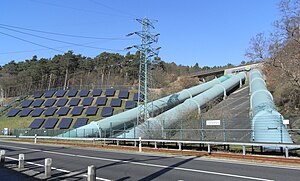Solar energy is not available at night, making energy storage an important issue in order to provide the continuous availability of energy.[73] Both wind power and solar power are intermittent energy sources, meaning that all available output must be taken when it is available and either stored for when it can be used, or transported, over transmission lines, to where it can be used. Wind power and solar power can be complementary, in locations that experience more wind in the winter and more sun in the summer, but on days with no sun and no wind the difference needs to be made up in some manner.[74]
The Solar Two used this method of energy storage, allowing it to store enough heat in its 68 m³ storage tank to provide full output of 10 MWe for about 40 minutes, with an efficiency of about 99%.[75] Salts are an effective storage medium because they are low-cost, have a high specific heat capacity and can deliver heat at temperatures compatible with conventional power systems, have the potential to eliminate the intermittency of solar power, by storing spare solar power in the form of heat; and using this heat overnight or during periods that solar power is not available to produce electricity. This technology has the potential to make solar power dispatchable, as the heat source can be used to generate electricity at will. Solar power installations are normally supplemented by storage or another energy source, for example with wind power and hydropower.
Off-grid PV systems have traditionally used rechargeable batteries to store excess electricity. With grid-tied systems, excess electricity can be sent to the transmission grid. Net metering programs give these systems a credit for the electricity they deliver to the grid. This credit offsets electricity provided from the grid when the system cannot meet demand, effectively using the grid as a storage mechanism. Credits are normally rolled over month to month and any remaining surplus settled annually.[76]
Pumped-storage hydroelectricity stores energy in the form of water pumped when surplus electricity is available, from a lower elevation reservoir to a higher elevation one. The energy is recovered when demand is high by releasing the water: the pump becomes a turbine, and the motor a hydroelectric power generator.[77]





0 comments:
Post a Comment